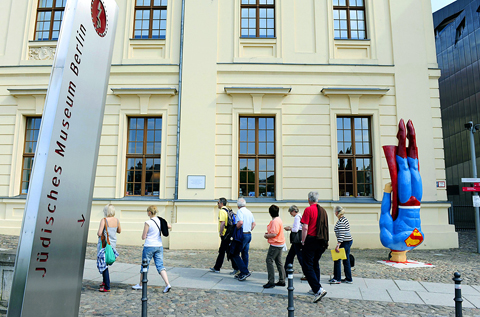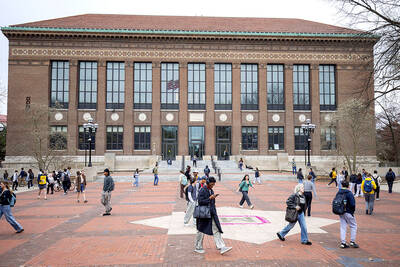If Superman had had his way, Hitler would have wound up begging for mercy before the League of Nations in Geneva in 1940, and there would never have been an Auschwitz.
A major new exhibition, which opened at Berlin’s Jewish Museum, argues it was no coincidence that the biggest superheroes including Superman, Spiderman, Batman and the Hulk were all created by Jewish comic artists.
“Heroes, Freaks and Superrabbis — the Jewish Color of Comics” looks at 45 of the most successful comic creators, overwhelmingly children of European Jewish families who had emigrated to New York.

PHOTO: AFP
As comic books entered their golden age in the 1930s and 1940s, the most iconic superheroes were products of those troubled times, even taking on Adolf Hitler and his Nazi henchmen before the Americans did.
“The point of the exhibition isn’t to say comics are a Jewish speciality,” said Anne Helene Hoog, one of the curators. “Rather, it looks at the question why so many Jews became comic artists, and what issues preoccupied them.”
In February 1940, nearly two years before Pearl Harbor, How Superman Would End the War by Jerry Siegel and Joe Shuster has the Man of Steel making quick work of the diminutive Nazi leader.
“I’d like to land a strictly non-Aryan sock on your jaw, but there’s no time for that!” Superman tells a groveling Hitler as he dispatches him to Switzerland to face justice, along with Stalin to boot.
A month later, Jack Kirby (born Jacob Kurtzberg) and Joe Simon’s Captain America thwarts a Nazi plot to invade the US with a wallop to the Fuehrer’s nose in a legendary cover sketch.
Hoog said the superheroes were often depicted, like their artists, as outsiders who, with an immigrant’s deep patriotism, battle to save their adopted home country from an outside threat.
That image resonated powerfully at a time when the world appeared to be falling apart, Hoog said.
“In light of the failure of democracy in Europe, it was clear that young people — particularly the children of immigrants, poor people, refugees — confronted with misery, fear, violence, injustice and finally extermination, were alarmed by what was happening in the world,” she said.
“In the 1930s, there was a deep need for superheroes,” she added, and Jewish artists were happy to oblige.
Although none of the major superheroes were overtly Jewish, their heroic journeys were often steeped in Old Testament imagery, noted Jewish Museum program director Cilly Kugelmann.
“Like Moses, Superman was discovered as an apparently abandoned baby and raised by the people who found him,” she said, adding that the character also had roots in Greek mythology, Germanic tales and the story of Jesus Christ.
Even “Shazam,” the magic word that turns young Billy Batson into 1970s-era Captain Marvel, had quasi-Jewish roots. The word is an acronym for the legendary heroes who inspire him and the first letter, “S,” stands for wise King Solomon of Israel.
Many of the comic artists worked as paper boys when they were young in the 1920s, selling newspapers amid the tenements on New York’s Lower East Side, where their love for the “funnies” was born.
After the war, with time Jewish graphic novelists began confronting the Holocaust, tentatively at first, and culminating in the harrowing Pulitzer-prize-winning Maus series by Art Spiegelman.
In the two volumes published in 1986 and 1991, Spiegelman tells the story of his Shoah-survivor father, a Polish-born Jew, and the author’s own feelings of guilt and rage toward him as he was growing up. With his literary ambition, Spiegelman revolutionized the genre.
Comics also accompanied the counterculture movement of the 1960s, with Mad magazine and subversive “comix” by Jewish women such as Trina Roberts and Aline Kominsky-Crumb.
Hoog said a current of irony runs through many of the works, highlighting Steve Sheinkin’s The Adventures of Rabbi Harvey and Rabbi Harvey Rides Again about a Jewish cleric superhero in the Wild West.
Punctuating the point, a caped Superman statue outside the museum shows him crashed into the pavement, with Krypton blood trickling from his head. The sculpture is called Even Superheroes Have Bad Days.

Swedish campaigner Greta Thunberg was deported from Israel yesterday, the Israeli Ministry of Foreign Affairs said, the day after the Israeli navy prevented her and a group of fellow pro-Palestinian activists from sailing to Gaza. Thunberg, 22, was put on a flight to France, the ministry said, adding that she would travel on to Sweden from there. Three other people who had been aboard the charity vessel also agreed to immediate repatriation. Eight other crew members are contesting their deportation order, Israeli rights group Adalah, which advised them, said in a statement. They are being held at a detention center ahead of a

A Chinese scientist was arrested while arriving in the US at Detroit airport, the second case in days involving the alleged smuggling of biological material, authorities said on Monday. The scientist is accused of shipping biological material months ago to staff at a laboratory at the University of Michigan. The FBI, in a court filing, described it as material related to certain worms and requires a government permit. “The guidelines for importing biological materials into the US for research purposes are stringent, but clear, and actions like this undermine the legitimate work of other visiting scholars,” said John Nowak, who leads field

Former Nicaraguan president Violeta Chamorro, who brought peace to Nicaragua after years of war and was the first woman elected president in the Americas, died on Saturday at the age of 95, her family said. Chamorro, who ruled the poor Central American country from 1990 to 1997, “died in peace, surrounded by the affection and love of her children,” said a statement issued by her four children. As president, Chamorro ended a civil war that had raged for much of the 1980s as US-backed rebels known as the “Contras” fought the leftist Sandinista government. That conflict made Nicaragua one of

NUCLEAR WARNING: Elites are carelessly fomenting fear and tensions between nuclear powers, perhaps because they have access to shelters, Tulsi Gabbard said After a trip to Hiroshima, US Director of National Intelligence Tulsi Gabbard on Tuesday warned that “warmongers” were pushing the world to the brink of nuclear war. Gabbard did not specify her concerns. Gabbard posted on social media a video of grisly footage from the world’s first nuclear attack and of her staring reflectively at the Hiroshima Peace Memorial. On Aug. 6, 1945, the US obliterated Hiroshima, killing 140,000 people in the explosion and by the end of the year from the uranium bomb’s effects. Three days later, a US plane dropped a plutonium bomb on Nagasaki, leaving abut 74,000 people dead by the